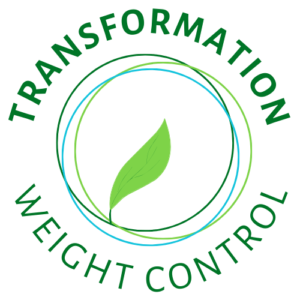by Richard Weil, M.Ed., CDE
Founder and Director
Transformation Weight Control
Habits come in two flavors, 1) negative or maladaptive, and 2) positive or adaptive. In this blog, what I have to say applies to both equally.
Factors Involved in Habit Formation
Repetition
A lot of people believe that habits are formed by repetition only. The model goes like this: 1) you get triggered by a thought, event, or association to some stimuli, then 2) you repeat the same behavior as you have done in the past in response to the trigger, and then 3) you are rewarded for the behavior.
In practical terms, 1) you’re walking down the street and see a food vendor, or smell food, or see someone eating, or drive by your favorite fast-food restaurant, then 2) you respond to the stimuli by deciding to eat, consciously or unconsciously, intentionally or unintentionally, habitually or automatically, and then 3) you eat are rewarded for that behavior because the food tastes good, satisfies your craving, calms your emotional arousal such as anxiety or stress, and/or any other secondary gain you receive from acquiring and consuming the food. Secondary gain is the hidden or indirect benefit you experience from a behavior, e.g., a) food is critical for survival (primary gain), and b) eating more than you need to soothe or calm yourself, frequently known as emotional eating, is the secondary gain.
Context
But repetition is only one part of the story. Context is next. That is, where and when do you repeat your habit? What is the environment like where or when you behave habitually? For instance, you brush your teeth every morning, so the context is very simple. Ever since you were a kid, you wake up in the same bedroom, you go to the bathroom, and then brush your teeth. That environment, and time of day, is about as consistent as it gets. That’s why you really don’t have to think about brushing your teeth (but don’t forget to floss, which is a more difficult habit to acquire than brushing your teeth!)
What about time of day as the context? Is 4:00pm when your food cravings start? Is it because you are hungry since you haven’t eaten since lunch at noon, or maybe you skipped breakfast and lunch altogether. Or is 7:00am a crazy time at home getting kids ready for school, preparing breakfast, getting yourself ready. All this chaos could lead to unconscious, habitual, maladaptive behaviors such as rushing and grabbing the first thing you see in the fridge, or a muffin at the deli on your way to work, even if it’s not what you originally had planned for breakfast. Is the time of day a familiar story for triggering a habitual behavior? Ask yourself, what is it about the time of day that is the trigger for habitual, maladaptive behaviors? Some say we make the same decisions ….
Behavior Links
Next in the chain of events that leads to habit formation are behavior links. What events, locations, behaviors, or emotions, do you associate with food? For example, where do you frequently eat at home? Are you on your sofa watching TV? If so, then doesn’t it make sense that every time you see or sit on the sofa, or watch TV, that the association to eating will pop up? Or do you eat in bed frequently? Then doesn’t it make sense that bed becomes associated with food and eating? Or emotions. Do you eat when you are stressed? Food is an effective vehicle for soothing and calming yourself, so you are rewarded and your stress and anxiety decrease, but of course, do this frequently enough and you are going to gain weight. But the damage is done; you have now associated high stress, or some other emotion, with eating. You get the idea. Think about how many behavior links there are in your life that you associate with eating. Weight loss behaviors operate similarly when it comes to habit, whether it’s food, eating, exercise, or anything else related to those efforts.
Memory
Memory is critical for learning new or repeating old behaviors. Think how powerful your memory is. Usually, our memories are stronger about events of very high and positive emotion, or low and negative emotion, and not neutral events, but this may not always be the case when it comes to food. In our groups, I sometimes ask, “what’s your favorite food from childhood?”. Most people raise their hands almost immediately, but when I ask what they had for lunch yesterday, they have no recall of it or have to take a few minutes to remember. And once you “hard-wire” memories into your brain, positive or negative behaviors, the brain is very effective at remembering primary and secondary gains.
State-dependent memory is also an important factor. It refers to a circumstance where you are more likely to recall events or information that happened in the past if you are in the same state of mind, or mood, currently, that you were previously were. For example, if you have many strong and negative memories of being teased because of your weight as a kid, then if someone teases you as an adult, it’s likely the same memory of the feeling you experienced as a kid will surface, and you cope the same as you did when you were younger, and maybe that means extra eating to soothe yourself. Does that ever happen to you?
Control At the Core
At the heart of all these factors in forming maladaptive habits is lack of control. At TWC, you will learn through insight, connections, behavior skills, strategies, and support from other group members who “get it”, and a compassionate and experienced staff, how to gain control. Wouldn’t that be nice?
Habitual vs Automatic
There’s a subtle but significant difference between a behavior that is habitual and one that is automatic. Habitual behaviors still require some thought; automatic responses require very little, to no thought, such as brushing your teeth from my example above. As you practice and get rewarded for your positive behaviors, the brain lays down “new wiring”, new pathways of new adaptive memories, and over time, with practice, these behaviors move beyond habitual, to automatic.
Managing and Developing New and Adaptive Habits
There are many strategies for developing new and adaptive habits. We teach all the strategies at TWC. At the heart of it is to set realistic goals that you can accomplish. When you do that, you get rewarded for positive behaviors, which build self-efficacy, the central belief that “I can”. When you believe you can, you normally do. But it takes building self-efficacy, which means setting realistic goals that you can achieve so that you feel rewarded and good about the behavior. Then your brain will remember that positive experience, and as a result, the experience becomes more habitual.
Here are five of the many tried and true strategies for establishing new positive and adaptive habits that we teach at TWC.
Intention-Implementation. Much research has been done in this area. Researchers believe that intention counts for about 20% to 30% of your behavior change, implementation is 70% to 80%. Which means a plan is instrumental in adopting behavior change, and that you implement it is the most critical of all. With the accomplishment comes self-efficacy and your brain remembering. Then you are on your way to developing new, adaptive habits.
If-Then planning. In a nutshell, this is contingency planning. Say you set a goal to take a walk for exercise, and it’s raining when the time comes. So, you say, “I have a plan to walk at 7:30am, but IF it’s raining, THEN I will either carry an umbrella, wear rain gear (it’s only water), or I walk in my building hallway, or climb stairs, or get on my stationary bike. Research shows that people lose more weight when they use If-Then panning then if they don’t.
Set plans based on context, not time. For example, some people feel it’s too restrictive to set a specific time of day to exercise, so instead, they use time context. That is, they say they will do their exercise after waking up but before breakfast. Less pressure than saying strictly and specifically, 7:30am, which you might resent, rebel, and never get the job done.
Mental contrasting. Write down or think about several of the positive aspects of the behavior change of interest, and then list the impediments that might get in the way. Hone in on the largest impediments first, and problem-solve by yourself, or some you trust, for solutions to those impediments. For example, if you set a plan to exercise after work but before dinner, but you know you often have to work late, then this plan is not going to work a lot of the time, so problem-solving might bring you to the conclusion to exercise in the morning. My experience for people who say they aren’t a morning person is that once you get going on it, over time, you get rewarded, and morning exercise no longer feels like an insurmountable impediment.
Coping Plan. Set plans with strategies as specifically and realistic as you can. Effective planning strategies that are realistic have been proven to improve weight loss then vague plans. Saying I’ll walk on Saturday is less likely to happen than if you say, “I’ll walk right after breakfast for 30 minutes around the block. My favorite walking plan is 5-minutes out, 5-minutes back. That is, you look at your watch, start walking away from your home for 5-minutes, and at 5-minutes, turn around and walk home. There it is, 10 minutes, just like that!
How long does it take to form a habit?
Research by psychologist Phillipa Lally published in the European Journal of Social Psychology in 2010 investigated the process of habit formation and how long it took for activities of daily living to become automatic.
THE STUDY. Ninety-six volunteers chose an eating, drinking or physical activity behavior to carry out daily in the same context (for example ‘after breakfast’) for 12 weeks. Each day they recorded whether they carried out the behavior. The researchers created graphs to show when a behavior became automatic. When the graph line flattened out, it meant the behavior had become a habit. If the line did not flatten out, then it was going to take longer than the 12 weeks of the study (84 days).
Here are the graphs with the behavior and how long it took for them to become automatic, if it did in 84 days. Remember, when the graph line flattens out, the behavior has become automatic.
Here are the graphs. Interesting. Click HERE for the original article.
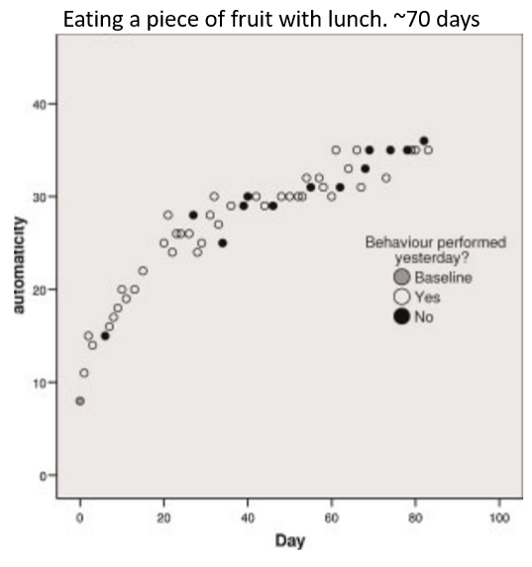

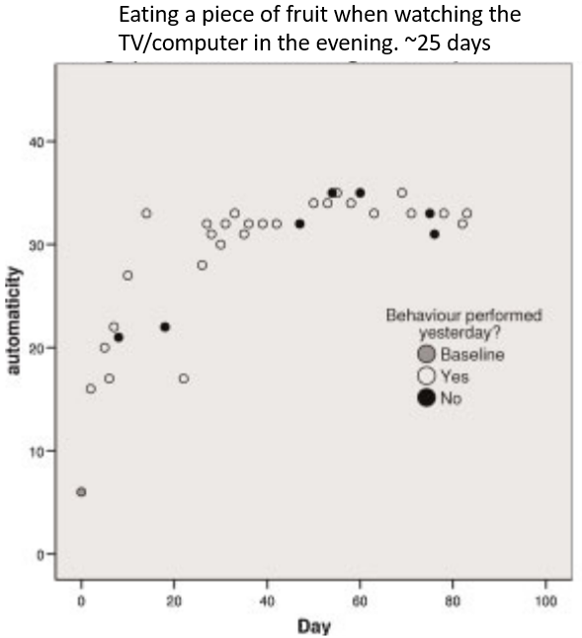
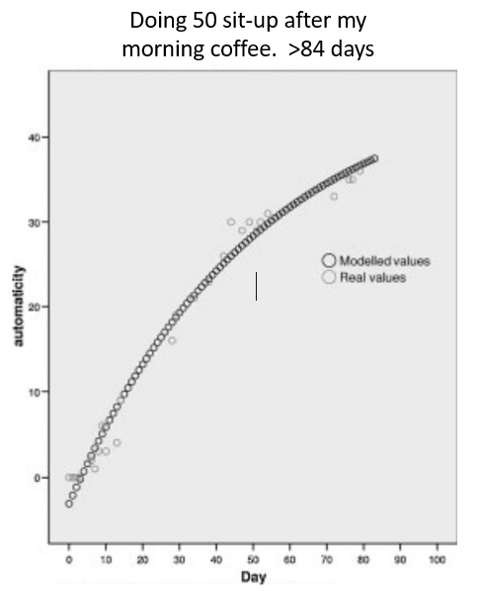
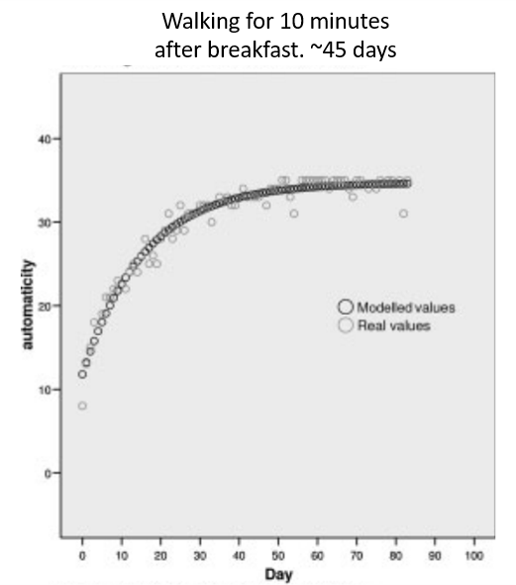
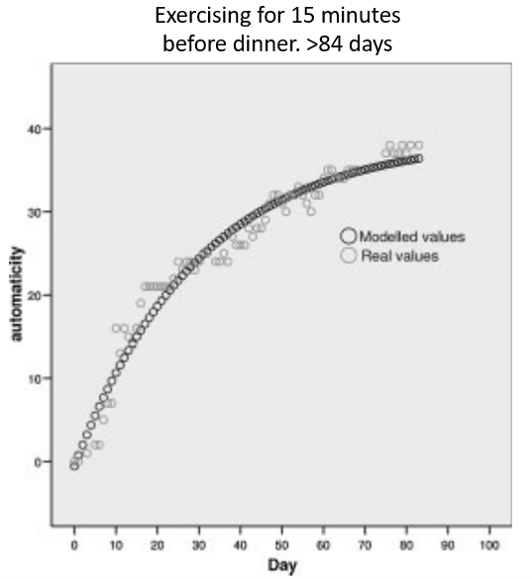
Wrapping Up
I thought I would finish with some interesting take-aways about habits based on quotations and research.
We are what we repeatedly do. Attributed to Aristotle, although some people believe the philosopher Will Durant modified a quote by Aristotle to make it this. Steve Jobs, founder of Apple Computers, said he would trade all his technology for an afternoon with Socrates!
Cainotophobia. Definition: an abnormal fear of newness. Don’t be afraid to step outside your comfort zone to establish new, positive habits!
We have 60,000 thoughts a day (Cleveland Clinic). On average, 80% of the habitual thoughts are negative and 95% are the same ones each day!
It is estimated that up to 45% of behavior tends to be repeated in the same physical location almost every day! Talk about context! (Barker and Schoggen 1978)
“It seems that most of the time what we do is what we do most of the time.” (unattributed)
We make over 200 food decisions per day. Most of these decisions appear to be ‘automatic’ or habitual, which means that we unconsciously eat without reflection, deliberation or any sense of awareness of what or how much food we select and consume. (Nilsen et al Implementation Science 2012)
So, go ahead, take a risk. Experiment with establishing new habits. Make the change from negative, maladaptive habits to positive, adaptive ones. Step outside your comfort zone!
Or join us at TWC and we’ll help you do it! We know how, we’ve been at it since 2001, and we’re good at it!
© Richard Weil, M.Ed. CDE, 2024, All Rights Reserved

